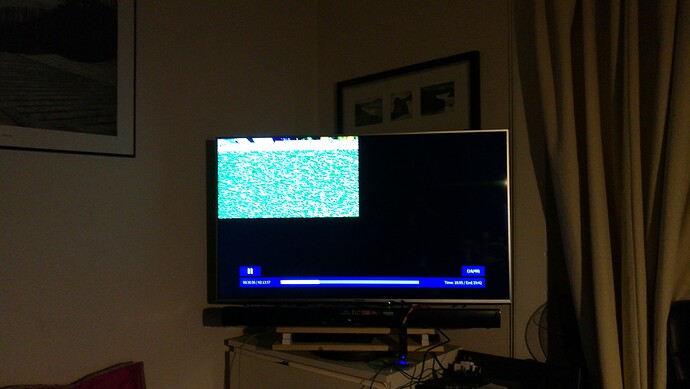I got my Vero 4K today and have been trying it with various 4k files which previously I couldnt play and mostly everything has played fine.
However there is one file, a large 45gb 4K HDR which refuses to play and will only buffer. I figured it was too high bitrate to play over the network and copied it to a usb but it wont even play off the usb (correction after buffering for a few minutes it suddenly starts playing like 30 minutes in and with a weird screen, see attached)
Media info reports its less than 40mb/s so it should play fine, right? Is it likely that its just a bad rip?
Media info for the file follows:
Video
ID : 1
Format : HEVC
Format/Info : High Efficiency Video Coding
Format profile : @L5@High
Codec ID : V_MPEGH/ISO/HEVC
Duration : 2 h 13 min
Bit rate : 39.8 Mb/s
Width : 3 840 pixels
Height : 1 608 pixels
Display aspect ratio : 2.40:1
Frame rate mode : Constant
Frame rate : 23.976 (24000/1001) FPS
Color space : YUV
Chroma subsampling : 4:2:2 (Type 2)
Bit depth : 10 bits
Bits/(Pixel*Frame) : 0.269
Stream size : 37.2 GiB (86%)
Title : TEKNO3D.com Rogue One: A Star Wars Story 4K VISIONPLUSHDR-1000 4:2:2 Edition
Writing library : x265 2.3+17-6e348252e902:[Windows][GCC 6.3.0][64 bit] 10bit
Encoding settings : cpuid=1173503 / frame-threads=3 / numa-pools=8 / wpp / no-pmode / no-pme / no-psnr / no-ssim / log-level=2 / input-csp=2 / input-res=3840x1608 / interlace=0 / total-frames=192703 / level-idc=0 / high-tier=1 / uhd-bd=0 / ref=1 / no-allow-non-conformance / repeat-headers / annexb / no-aud / no-hrd / info / hash=0 / no-temporal-layers / no-open-gop / min-keyint=23 / keyint=250 / bframes=3 / b-adapt=0 / b-pyramid / bframe-bias=0 / rc-lookahead=5 / lookahead-slices=8 / scenecut=40 / no-intra-refresh / ctu=32 / min-cu-size=16 / no-rect / no-amp / max-tu-size=32 / tu-inter-depth=1 / tu-intra-depth=1 / limit-tu=0 / rdoq-level=0 / dynamic-rd=0.00 / no-signhide / no-tskip / nr-intra=0 / nr-inter=0 / no-constrained-intra / strong-intra-smoothing / max-merge=2 / limit-refs=0 / no-limit-modes / me=3 / subme=5 / merange=57 / temporal-mvp / no-weightp / no-weightb / no-analyze-src-pics / deblock=0:0 / no-sao / no-sao-non-deblock / rd=2 / early-skip / no-rskip / fast-intra / no-tskip-fast / no-cu-lossless / no-b-intra / rdpenalty=0 / psy-rd=4.00 / psy-rdoq=0.00 / no-rd-refine / analysis-mode=0 / no-lossless / cbqpoffs=0 / crqpoffs=0 / rc=abr / bitrate=40000 / qcomp=0.60 / qpstep=1 / stats-write=0 / stats-read=0 / ipratio=1.10 / pbratio=1.00 / aq-mode=0 / aq-strength=0.00 / no-cutree / zone-count=0 / no-strict-cbr / qg-size=32 / rc-grain / qpmax=69 / qpmin=0 / sar=0 / overscan=0 / videoformat=5 / range=0 / colorprim=9 / transfer=16 / colormatrix=9 / chromaloc=1 / chromaloc-top=2 / chromaloc-bottom=2 / display-window=0 / master-display=G(8500,39850)B(6550,2300)R(35400,14600)WP(15635,16450)L(100000000,1) / max-cll=10000,180 / min-luma=0 / max-luma=1023 / log2-max-poc-lsb=8 / vui-timing-info / vui-hrd-info / slices=1 / opt-qp-pps / opt-ref-list-length-pps / no-multi-pass-opt-rps / scenecut-bias=0.05 / no-opt-cu-delta-qp / no-aq-motion / hdr / no-hdr-optrefine-level=5
Default : Yes
Forced : No
Color range : Limited
Color primaries : BT.2020
Transfer characteristics : PQ
Matrix coefficients : BT.2020 non-constant
Mastering display color primaries : BT.2020
Mastering display luminance : min: 0.0001 cd/m2, max: 10000 cd/m2
Maximum Content Light Level : 10000 cd/m2
Maximum Frame-Average Light Level : 180 cd/m2
Audio #1
ID : 2
Format : DTS
Format/Info : Digital Theater Systems
Format profile : MA / Core
Codec ID : A_DTS
Duration : 2 h 13 min
Bit rate mode : Variable / Constant
Bit rate : 5 136 kb/s / 1 509 kb/s
Channel(s) : 8 channels / 6 channels
Channel positions : Front: L C R, Side: L R, Back: L R, LFE / Front: L C R, Side: L R, LFE
Sampling rate : 48.0 kHz
Frame rate : 93.750 FPS (512 SPF)
Bit depth : 24 bits
Compression mode : Lossless / Lossy
Delay relative to video : 3 ms
Stream size : 4.80 GiB (11%)
Title : English DTS-HD Master Audio 7.1
Language : English
Default : Yes
Forced : No
Audio #2
ID : 3
Format : AC-3
Format/Info : Audio Coding 3
Codec ID : A_AC3
Duration : 2 h 13 min
Bit rate mode : Constant
Bit rate : 640 kb/s
Channel(s) : 6 channels
Channel positions : Front: L C R, Side: L R, LFE
Sampling rate : 48.0 kHz
Frame rate : 31.250 FPS (1536 SPF)
Bit depth : 16 bits
Compression mode : Lossy
Delay relative to video : 24 ms
Stream size : 613 MiB (1%)
Title : French AC-3 5.1
Language : French
Service kind : Complete Main
Default : No
Forced : No
Audio #3
ID : 4
Format : AC-3
Format/Info : Audio Coding 3
Codec ID : A_AC3
Duration : 2 h 13 min
Bit rate mode : Constant
Bit rate : 640 kb/s
Channel(s) : 6 channels
Channel positions : Front: L C R, Side: L R, LFE
Sampling rate : 48.0 kHz
Frame rate : 31.250 FPS (1536 SPF)
Bit depth : 16 bits
Compression mode : Lossy
Delay relative to video : 24 ms
Stream size : 613 MiB (1%)
Title : Spanish Latino AC-3 5.1
Language : Spanish
Service kind : Complete Main
Default : No
Forced : No
